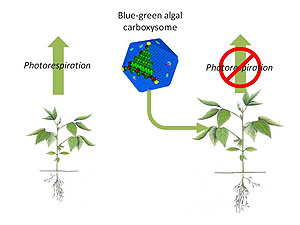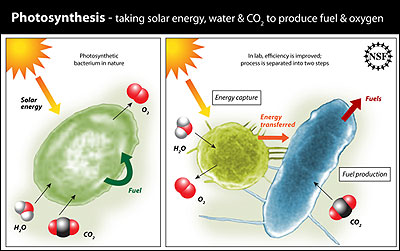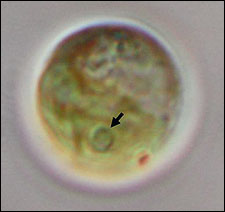Scientists in the US and the UK have been awarded funding totaling more than $10.3 million to improve the process of biological photosynthesis. The US National Science Foundation (NSF) and the UK Biotechnology and Biological Sciences Research Council (BBSRC) collaborated in issuing these jointly funded awards.

EPP will engineer into cells protein structures that reduce photorespiration and boost photosynthesis. (Image: Elizabeth Yendrek, Melissa Edwards and Steve Long, University of Illinois; and Seth Axen and Cheryl Kerfeld, UC-Berkeley)
Four transatlantic research teams will explore ways to overcome the limitations of photosynthesis and to develop new methods of significantly increasing the yields of important crops for food production and/or sustainable bioenergy.
The funding agencies used a method called an "Ideas Lab," developed by the UK's Engineering and Physical Science Research Council, to stimulate new conversations about old problems. The result was the generation and real-time review of high-risk but potentially high-impact proposals for increasing the efficiency of photosynthesis.

In photosynthesis, solar energy is captured and used to produce chemical fuel by a photosynthetic organism. This project is designed to improve the efficiency of this capture and conversion by: 1) separating them into two types of cells, one that captures solar energy and another "factory" cell that produces fuel; and 2) enabling these two different types of cells to communicate with one another via the flow of electrical currents between them. Compartmentalizing the processes of energy capture and fuel production into two different types of cells will allow researchers to optimize environments for each process and thereby improve the efficiency of each process. (Image: Zina Deretsky, NSF)
The NSF and the BBSRC are now releasing four awards for proposals, each of which addresses a different bottleneck in photosynthesis, that were produced through the alternative approach pioneered at the Ideas Lab. NSF is contributing a total of $5.2 million to support US participants in these projects.
The four projects selected for funding at the Ideas Lab will conclude in about three years, at which time the two funding agencies will examine the approaches taken by these projects for addressing photosynthetic energy to determine whether the Ideas Lab approach realized its potential to generate novel and potentially transformative outcomes.

The CAPP project will characterize the photosynthetic-boosting pyrenoid (arrow) captured by phase contrast microscopy. (Image: Moritz Meyer, University of Cambridge)
Summaries of the four funded projects are as follows:
- Plug and Play Photosynthesis, led by Anne Jones of Arizona State University: This project is designed to separate the capture and conversion of solar energy into fuel – processes that may be completed by a single cell – into two different organisms that would communicate with one another through electrical currents flowing between them. This separation of photosynthetic processes into different organisms will enable researchers to optimize environments for each of these processes and improve their efficiency.
- Exploiting Prokaryotic Proteins to Improve Plant Photosynthesis Efficiency (EPP), led by Stephen Long of the University of Illinois: A metabolic process known as photorespiration reduces the yields of plants, including major crops such as soy, wheat and rice, by an estimated 20 to 50 percent. Some blue-green algae have protein structures called carboxysomes that reduce such losses. This research aims to adapt and engineer these protein structures into crop plants to minimize photorespiration and boost yield.
- Multi-Level Approaches for Generating Carbon Dioxide (MAGIC), led by John Golbeck of Pennsylvania State University: Through this project, researchers will attach to the membranes of photosynthesizing cells special proteins that will pump carbon dioxide from the atmosphere into cells. Resulting increases in the availability of carbon dioxide inside these cells will inhibit photorespiration and promote photosynthesis.
- Combining Algal and Plant Photosynthesis (CAPP), led by Martin Jonikas of Stanford University: The unicellular green alga Chlamydomonas has a pyrenoid: a ball-shape structure within the cell that helps this alga assimilate carbon to improve its photosynthetic efficiency. The goal of this project is to characterize the pyrenoid and associated components, and to transfer them to higher plants to improve their photosynthetic efficiency.
For more information, visit: www.nsf.gov